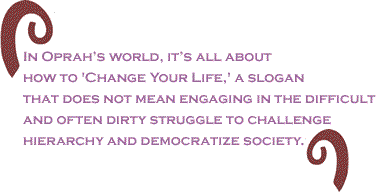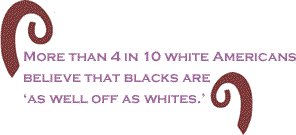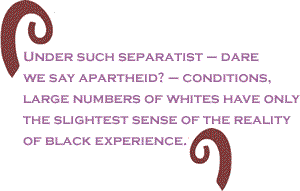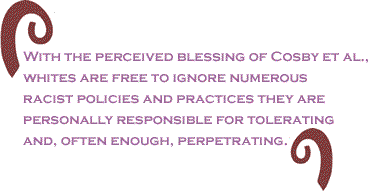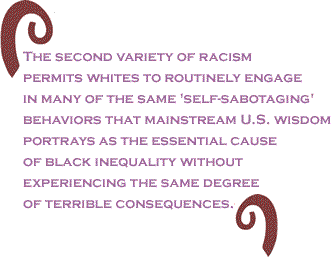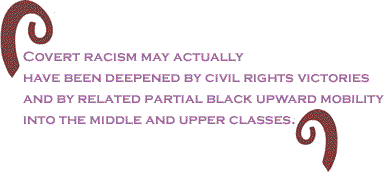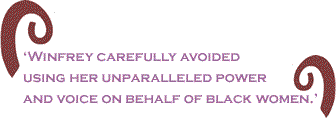
|
|||||||||||||||||||||
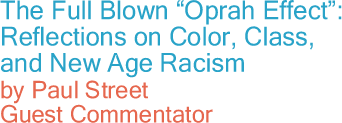 |
“The culture of New Age Racism also brought blacks to the age of Oprah” – Elaine Brown, 2002 “A Real Black-Tie Event:” I recently caught a snippet of television that was relevant for understanding the savage persistence of stark racial inequality in the United States. I was flipping the dial late at night and caught part of Oprah. She was speaking to Oscar favorite Jamie Fox, who appeared on a giant screen, sitting in front of a piano. They were talking about his experience playing Ray Charles in the movie “Ray.” The multi-billionaire Oprah mentioned that she realized she could “be anything I wanted to be” when Sidney Poitier won the first Academy award ever given to an African American. She told Jamie that she loved him. The multi-millionaire Jamie informed Oprah that he loved her back. They spoke cheerfully about the significant black presence that will be displayed at this year’s Academy Awards ceremony, which is being hosted by the black comedian Chris Rock. “It’s really going to be a black-tie event this year,” Jamie said. Everybody laughed.
Jamie played a song on the piano. Oprah and Jamie exchanged some more “I love yous.” It looked like Oprah was tearing up. Many of her predominantly white female audience members seemed equally moved. They were happy for Jamie and Oprah and Chris Rock and all the other African-Americans who have “made it” in the United States. And they were happy for America’s benevolent decision to slay the beast of racism and open the doors of equal opportunity to all. It was another chance for white self-congratulation and for whites to forget about – and lose more sympathy for – the large number of black Americans who are nowhere close to making it in post-Civil Rights America. Still Savage Inequalities
For a considerable portion of whites in “post-Civil Rights” America, black-white integration and racial equality are more than just accepted ideals. They are also, many believe, accomplished realities, showing that we have overcome racial disparity. According to a survey conducted by the Washington Post, the Henry J. Kaiser Foundation, and Harvard University in the spring of 2001, more than 4 in 10 white Americans believe that blacks are “as well off as whites in terms of their jobs, incomes, schools, and health care.” The 2000 US Census numbers that were being crunched as this poll was taken did not support this belief. More than three and a half decades after the historic victories of the black Civil Rights Movement, the census showed, equality remained a highly elusive goal for African-Americans. In a society that possesses the highest poverty rate and the largest gaps between rich and poor in the industrialized world, blacks are considerably poorer than whites and other racial and ethnic groups. Economic inequality correlated so closely with race that:
Meanwhile, blacks were 12.3 percent of U.S. population, but comprised nearly half of the roughly 2 million Americans currently behind bars. Between 1980 and 2000, the number of black men in jail or prison grew fivefold (500 percent), to the point where, the Justice Policy Institute reported in 2002, there were more black men behind bars than enrolled in colleges or universities in the U.S. On any given day, 30 percent of African-American males ages 20 to 29 were under correctional supervision – either in jail or prison or on probation or parole. According to the best social science estimates in 2002, finally, one in five black men was saddled with a prison record and an astounding one in three black men possessed a felony record. “They’ve Got the NBA – What More Do They Want?” Ask white Americans who think that blacks are equal to (or even ahead of) whites what exactly they are talking about and you won’t get census data. You’ll hear about Oprah, Michael Jordan, Condoleezza Rice, Colin Powell, Barack Obama, the guy who leads Jay Leno’s band, or the black lawyer or doctor who recently moved into their neighborhood. The white father of a white friend of mine contributes the following pearl of wisdom regarding what he sees as black Americans’ exaggerated sense of grievance and entitlement: “they’ve got the NBA – what more do they want?” Wildly popular among white viewers, “The Cosby Show” helped fuel some of this sort of thinking during the Reagan era. As left culture critic Mark Crispin Miller noted in a 1986 essay titled “Cosby Knows Best,” the affluent, hyper-consumerist, apolitical African-American Huxtable family – headed by the affable, impish obstetrician Cliff (played by Dr. Cosby himself) – functioned as “an ad, implicitly proclaiming the fairness of the American System: ‘Look! [Cosby shows us] Even I can have all this!’” “On ‘The Cosby show,’” Miller noted, “it appears as if blacks in general can have, and do have, what many whites enjoy and that such material equality need not entail a single break-in. And there are no hard feelings, none at all, now that the old injustices have been so easily rectified.” Consistent with its mission of selling the American System and the related idea that America’s racial divisions had been overcome, “The Cosby Show” refused to permit any “negativity” on the screen. “This is a conscious policy,” Miller noted, observing that “Dr. Alvin Poussaint, a professor of psychiatry at Harvard, reads through each script as a ‘consultant,’ censoring any line or bit that might somehow tarnish the show’s ‘positive image.’ And the show’s upscale mise-en scene has also been deliberately contrived to glow, like a fixed smile. ‘When you look at the artwork [on the show’s walls], there is a positive feeling, an up-feeling,’ Cosby says. ‘You don’t see downtrodden, negative I Can’t Do, I won’t do.’” Separatism and Its Consequences Part of the problem behind many whites’ racial equality understanding gap is segregation, which continues at high levels. White women might flock en masse to their black princess Oprah’s Chicago television studio to receive inspiration, wisdom, and (on lucky days) surplus commodities, but Oprah’s home city is harshly segregated by race. The Chicago metropolitan area has a black-white dissimilarity measure of 80.8, meaning that more than four out of every five area blacks would have to move for African-Americans to be distributed evenly with whites throughout the metropolitan area. Within Chicago, 74 percent of black residents live in neighborhoods that are 90 percent or more African-American. The average Chicago black lives in a census tract where 4 of every 5 residents (81.1%) are African-American, while the average white lives in a census tract where less than 1 in 10 people (8.9 percent) is African-American. Fifty years after the Brown v. Board of Education decision ruled that “separate is unequal,” the average black K-12 public student in Chicago attends a school that is 86 percent black. Two hundred and seventy four schools, (or 47 percent) of the city’s 579 public elementary and high schools are 90 percent or more African American and 173 of these schools – or 30 percent of all public schools in the city – are 100 percent black.
Of the half million blacks living outside Chicago in the six county Chicago metropolitan area in 1999, 70 percent lived in Chicago’s Cook County, the great majority residing south of the central city. More than half (52 percent) of all suburban blacks reside in just 13 south suburban Cook County towns – this in a broader metropolitan area that is home to 265 local municipalities. Under such separatist – dare we say apartheid? – conditions (and Chicago is no longer the most segregated city in the nation), large numbers of whites have only the slightest sense of the reality of black experience. The corporate-electronic visual mass culture is their main source on that experience and that medium presents a dangerously schizophrenic image of black America split between super-successful and largely admirable (not-all-that) black superstars (Oprah being the best of all) and dangerous (all-too) black perpetrators (though many successful black athletes and artists inhabit what seems to be in an intermediary category of their own: successful perpetrators). The majority of ordinary, hard-working black Americans who happen to be neither rich nor criminal are amazingly invisible on television and in the broader white-owned corporate communications empire. “We Got the Message…Now Get On With It” In my teaching and public-speaking experience, you can make progress with some whites who mistakenly think blacks are now “equal” (or better) by reminding them that the only blacks they “know” are on their televisions and citing the relevant disparity statistics. The really intractable blocks to white racial understanding revolve around the “why,” not the “what” of racial disparity. Insofar as stark differences in wealth, health, income, security and general well-being persist between blacks and whites, the large majority of white Americans deny that anti-black racism is the cause. Many whites point to the elimination of numerous discriminatory laws and barriers as well as the passage of equal employment legislation and affirmative action as proof that American society “bent over backwards” to guarantee blacks equal opportunity. Convinced that racism is no longer a significant problem for blacks, most whites find the real barriers to black success and equality within the African-American community itself. If problems for blacks persist, many whites and some privileged blacks (e.g. John McWhorter at the Manhattan Institute) think it’s only because too many blacks engage in “self-sabotaging” behaviors. “As white America sees it,” note Leonard Steinhorn and Barbara Diggs-Brown in their excellent study By The Color of Their Skin: the Illusion of Integration and the Reality of Race, (2000), “every effort has been made to welcome blacks into the American mainstream and now they’re on their own.” In the glorious self-help “New Age,” it’s all about self-victimization and self-help. The thing is for black people to conquer their inner demons. Predominant white attitudes at the turn of the millennium are well summarized by the comments of a white respondent to a survey conducted by Essence magazine. “No place that I’m aware of,” wrote the respondent, “makes [black] people ride on the back of the bus or use a different restroom in this day and age. We got the message; we made the corrections – get on with it.” Black Bourgeois Victim-Blaming as Music to White Ears Even among some African-American intellectuals who describe themselves as “left” and/or “center-left,” there is a tendency in “the post-Civil Rights” era to question the notion that “race” or (more accurately) racism is a significant reason for the persistently disproportionate presence of blacks at the bottom of America’s steep socioeconomic and institutional hierarchies. In a recent PBS documentary revealingly titled “America Beyond the Color Line,” Harvard’s reigning black intellectual Henry Louis “Skip” Gates argues that “class” has replaced “race” as the main problem for black America. “Class” for Gates means that that poor blacks need to work harder and smarter to acquire the skills, education, habits and values possessed in greater degree by their black economic superiors, including the leading US imperialist (favorably portrayed in “Beyond The Color Line”) Colin Powell, who is featured as an example of what blacks can accomplish when they work hard, study, save and behave decently. The main “class problem” that Gates portrayed in “America Beyond” is that poor blacks just don’t…well…have any (class, that is). “Unless there is a moral revolution and a revolution in attitude among our people,” Gates says, “unless [poor blacks] decide to stay in school, learn the ABCs, not to get pregnant when you’re 16, not to run drugs, not to sell drugs…we’re doomed to have a relatively small black middle class and huge underclass and never the twain shall meet. The only way we can succeed in society,” Gates told the Chicago Tribune in 2003, “is by mastering the ABCs, staying in school, working hard, deferred gratification. What’s happened to these values?,” asks Gates. “My father always said,” Gates elaborated, “and it’s true, if we studied calculus like we studied basketball, we’d be running MIT. It’s true and there’s no excuse” (Johnson, “Beyond Gates”). This was the key theme in Gates’ earlier PBS documentary “Two Nations.” In that earlier rendition of his version of the “class over race” thesis, Gates proclaimed that black poverty was about poor decisions: “deciding to get pregnant or not to have protected sex. Deciding to do drugs. Deciding not to study. Deciding, deciding, deciding…”
By my Caucasian experience, this sort of talk is music to most whites’ ears. The majority of whites love to see black middle- and upper-class authority figures blame non-affluent blacks for their own problems. “See,” millions of American whites murmured after Cosby celebrated the 50th anniversary of the Brown decision by assaulting the black community’s “lower economic people”…. “…see this is what I mean. It’s their own fault. Don’t take it from me, don’t talk about racism, listen to one of their own. Listen to Bill Cosby.” With the perceived blessing of Cosby et al., whites are free to ignore numerous racist policies and practices they are personally responsible for tolerating and, often enough, perpetrating:
This list goes on. Racism’s Two Levels
The main problem with the conventional mainstream white wisdom on the disappearance of racism is a failure to distinguish adequately between overt and covert or institutional racism. The first variety of racism has a long and sordid history. It includes such actions, policies and practices as the burning of black homes and black churches, the public use of derogatory racial slurs and epithets, the open banning of blacks from numerous occupations, the open political disenfranchisement of blacks and the open segregation of public facilities by race. It is largely defeated, outlawed and discredited in the US. Witness the rapid public humiliation and political demotion of Trent Lott, who lost his position as United States Senate Majority Leader after he spoke in nostalgic terms about the openly segregationist 1948 Presidential campaign of Strom Thurmond. The second variety involves the more impersonal operation of social and institutional forces and processes in ways that “just happen” but nonetheless serve to reproduce black disadvantage in the labor market and numerous other sectors of American life. It includes racially discriminatory real estate and home-lending practices, residential “white flight” (from black neighbors), statistical racial discrimination in hiring and promotion, the systematic under-funding and under-equipping of schools predominately attended by blacks relative to schools predominately attended by whites, the disproportionate surveillance, arrest and incarceration of blacks and much more. It permits whites to routinely engage in many of the same “self-sabotaging” behaviors that mainstream U.S. wisdom portrays as the essential cause of black inequality without experiencing the same degree of terrible consequences as are visited upon blacks for “bad” beliefs and actions. Under its reign, poor blacks are lectured to get their values and behavior together but no wake-up call is issued for structurally empowered white Americans to stop “deciding, deciding, deciding” to:
The “Oprah Effect” and the Foretold Price of Civil Rights Victory
Richly enabled by policymakers who commonly declare allegiance to anti-racist ideals, the second, deeper level of racism has an equally ancient history that has more than merely outlived open, public American racism and the passage of civil rights legislation. Covert racism may actually be deepened by these civil rights victories and by related partial black upward mobility into the middle and upper classes insofar as those victories and achievements have served to encourage the illusion that racism has disappeared and that the only obstacles left to African-American success and equality are internal to individual blacks and their community – the idea that, in Derrick Bell’s phrase, “the indolence of blacks rather than the injustice of whites explains the socioeconomic gaps separating the races.” Indeed, “it’s hard,” Steinhorn and Diggs-Brown note, “to blame [white and even some black] people” for believing – falsely in Steinhorn and Diggs-Brown’s view – that racism is dead in America “when our public life is filled with repeated affirmations of the integration ideal and our ostensible progress towards achieving it.” “There are [now] enough examples of successful middle-class African-Americans,” Georgetown law professor Sheryl Cashin notes, “to make many whites believe that blacks have reached parity with them. The fact that some blacks now lead powerful mainstream institutions offers evidence to whites that racial barriers have been eliminated; the issue now is individual effort.” The “odd black family on the block or the Oprah effect – examples of stratospheric black success – feed,” Cashin observes, “these misperceptions, even as relatively few whites live among and interact daily with blacks of their own standing.” Episodes and events like the brief humiliation of Lott or the election of a black Mayor or U.S. Senator or City Hall’s criticism of racist sentiments on the part of bigoted white firemen offer opportunities for public officials and the broader mass culture to pat themselves on their back for advancing beyond the primitive state of open racism even while they promote policies that dig the hole of more covert institutional or societal racism yet deeper. Martin Luther King. Jr. sensed some of the danger here at the outset. He noted in 1967 that “many whites hasten to congratulate themselves on what little progress [black Americans] have made. I’m sure,” King opined, “that most whites felt that with the passage of the 1964 Civil Rights Act, all race problems were automatically solved. Most white people are so removed from the life of the average Negro,” King added, “there has been little to challenge that assumption.” “Change Your Life,” Not the System: The Full Effect Oprah’s usefulness in fueling white racism denial goes beyond the fact that she is one of the richest people in the world – sufficiently wealthy to periodically hand out millions of dollars worth of consumer goodies to hundreds of assembled middle-class white women in her studio audience. The full toxic “Oprah effect” is also about the how of her ascendancy. Like Powell, Rice, and perhaps now Obama, Oprah is perceived by many whites as succeeding because she’s “not all that black,” as Powell once described himself: because she has absorbed dominant white middle- and upper-class “self-help” values and rejects the supposedly obsolete and dysfunctional effort to make white America face up to – and pay for – its racist structures, policies, and practices, past and present.
It’s a carefully cultivated perception. With her army of disproportionately Caucasian counselors, personal trainers, fitness consultants, personal chefs, massage therapists, interior designers, and New Age healers, Oprah has taken an “inner journey” toward primarily personal healing and accountability and away from the collective struggle for racial equality and social justice. “The other kids were all into black power,” Oprah told the Tribune in the mid-1980s. But “I wasn’t a dashiki kind of woman … Excellence was the best deterrent to racism and that became my philosophy.” As her programming became ever more racially “sanitized” during the 1990s, Elaine Brown notes (in her excellent book The Condemnation of Little B [Boston, MA: Beacon Press, 2002]), Oprah’s emphasis focused on “providing …comfort to what became her core audience of white women, in the form of ‘lifestyle’ and glamour ‘makeovers,’ diets, and New Age self-healing readings and practices and endless self-deprecating discourse over her own weight and ‘nappy’ hair.” “Winfrey carefully avoided using her unparalleled power and voice on behalf of black women,” Brown bitterly observes, “even as the political agenda pounded poor black women and their children ever deeper into poverty and degradation.” Today, while American inequalities of class and color are worsened by racist imperial adventure in the Middle East, Oprah trumpets and exemplifies narcissistic personal obsession, egoistic wealth accumulation, and the narrow pursuit of individual “excellence” amidst permanent, unchallenged, and brutal social injustice. In Oprah’s world, it’s all about how to “Change Your Life,” a slogan that does not mean engaging with fellow African Americans, other people of color, and white allies in the difficult and often dirty struggle to challenge hierarchy and democratize society. It’s mainly about private color-blind solutions and personal experience. It means working with what Brown calls “a group of whites possessing curious credentials” (New Age healers and consultants), the great struggle to look and feel better inside the smaller circles of daily life – circles that happen, in Oprah’s case, to be situated at the super-opulent heights of a grotesquely unequal societal pyramid that grants more than 2 billion world citizens less than a dollar a day on which to live the good life that is sold in Oprah’s show and magazine. As for the participants in the upcoming and aforementioned “black tie event” (the Academy Awards), it is worth recalling the meaner side of black upper-class elitism, expressed by Chris Rock in his popular routine “Niggas vs. Black People.” Rock divides black America into two classes, Cosby’s “lower economic people” being the “Niggas.” “I love black people,” Rock says, “but I hate niggas! Boy, I wish they’d let me join the Klu Klux Klan.” Now there’s something for Oprah’s predominantly white audience to get teary-eyed about, after a bit of advice on how to decorate their next palatial Hollywood mansion more perfectly in accord with the unmet needs of their inner child. Paul Street ([email protected]) is the author of Empire and Inequality: America and the World Since 9/11 (Boulder, CO: Paradigm Publishers, 2004) and Still Separate, Unequal: Race, Place, Policy, and the State of Black Chicago (Chicago, IL: The Chicago Urban League, April 2005 |
| February 24 2005 Issue 127 |
|||||||||
|
|||||||||
|
|
|||||||||
| Printer Friendly Version | |||||||||
 |
|||||||||
 |
|||||||||
| |
|||||||||
| |
|||||||||





















